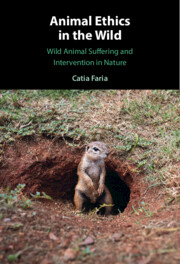Book contents
- Animal Ethics in the Wild
- Animal Ethics in the Wild
- Copyright page
- Contents
- Tables
- Acknowledgments
- Introduction
- Chapter 1 Moral Considerability
- Chapter 2 Speciesism
- Chapter 3 Wild Animal Suffering
- Chapter 4 Perversity and Futility
- Chapter 5 Jeopardy
- Chapter 6 Relationality
- Chapter 7 Priority
- Chapter 8 Tractability
- Conclusion
- References
- Index
Chapter 7 - Priority
Published online by Cambridge University Press: 18 January 2023
- Animal Ethics in the Wild
- Animal Ethics in the Wild
- Copyright page
- Contents
- Tables
- Acknowledgments
- Introduction
- Chapter 1 Moral Considerability
- Chapter 2 Speciesism
- Chapter 3 Wild Animal Suffering
- Chapter 4 Perversity and Futility
- Chapter 5 Jeopardy
- Chapter 6 Relationality
- Chapter 7 Priority
- Chapter 8 Tractability
- Conclusion
- References
- Index
Summary
This chapter assesses priority arguments against intervention in nature. First, on the Exclusion Approach, intervention is not a priority because equality and priority reasons simply do not apply to wild animals. Second, on the Deflation Approach, since nonhuman animals have a lower capacity for well-being, increasing wild animal well-being produces less value than increasing human well-being. Third, on the Perfectionist Approach, increases in nonhuman well-being cannot compensate for the loss of “the best things in life,” only attainable by human activity. We should, thus, give priority to increases in human well-being that ensure the existence of excellent goods. It is argued that all approaches have highly unacceptable results, particularly on the negative scale of well-being. Finally, the chapter considers the Domesticated Animals First objection, according to which priority should be given to alleviating the harms suffered by domesticated animals. It is argued that taken either as a substantive or as a strategic objection, it cannot soundly succeed.
Keywords
- Type
- Chapter
- Information
- Animal Ethics in the WildWild Animal Suffering and Intervention in Nature, pp. 144 - 167Publisher: Cambridge University PressPrint publication year: 2022

